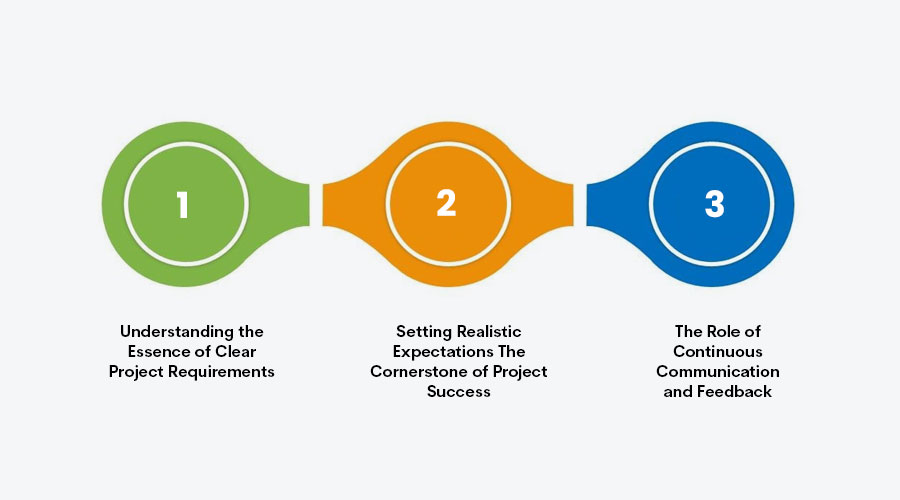Table of Contents
Indian Software Developers: An Overview
In the realm of technological innovation and digital advancement, the prowess of Indian software developers stands as an epitome of excellence. With their unmatched skills, ingenuity, and adaptability, Indian developers have cemented their position as global leaders in the software development landscape. Let’s delve into an insightful exploration of what makes them unparalleled.
1. Unmatched Technical Proficiency: Indian software developers are renowned for their exceptional technical acumen. Proficient in a plethora of programming languages such as Java, Python, C++, and more, they possess a versatile skill set that enables them to tackle complex development challenges with finesse. Their rigorous academic background coupled with hands-on experience equips them to craft robust and scalable solutions across various domains.
2. Innovation and Creativity: Innovation is ingrained in the DNA of Indian developers. Constantly pushing the boundaries of technology, they thrive on innovation-driven projects that demand creative problem-solving skills. Whether it’s developing cutting-edge mobile applications, AI-powered solutions, or IoT frameworks, Indian developers exhibit a remarkable ability to conceptualize and implement groundbreaking ideas, driving digital transformation globally.
3. Adaptable and Agile: In an ever-evolving tech landscape, adaptability is key, and Indian developers excel in this aspect. Agile methodologies such as Scrum and Kanban are deeply ingrained in their development culture, enabling them to deliver projects with speed and precision while remaining flexible to changing requirements. Their ability to swiftly adapt to new tools, frameworks, and methodologies ensures timely delivery and customer satisfaction.
4. Cost-Effectiveness: One of the compelling reasons why Indian software developers are in high demand globally is their cost-effectiveness. Offering competitive pricing without compromising on quality, Indian development firms provide excellent value propositions for businesses of all sizes. This cost advantage, coupled with high-quality deliverables, makes India a preferred outsourcing destination for software development projects across the globe.
5. Strong Work Ethic and Communication Skills: Indian developers are known for their strong work ethic and professionalism. Diligent and dedicated, they adhere to strict project timelines and deliver superior quality output consistently. Moreover, their proficiency in the English language facilitates seamless communication with clients and stakeholders worldwide, fostering transparency and collaboration throughout the development lifecycle.
6. Vibrant Tech Community: India boasts a vibrant and thriving tech community comprising developers, innovators, and thought leaders. From tech meetups and hackathons to conferences and online forums, the Indian tech ecosystem provides ample opportunities for knowledge sharing, networking, and skill enhancement. This collaborative environment fosters continuous learning and growth, nurturing the next generation of software developers.
Advantages of Hiring Indian Software Developers
In today’s digital era, where technology reigns supreme, businesses are constantly seeking ways to leverage the expertise of software developers to stay ahead in the game. Among the myriad of options available, hiring Indian software developers has emerged as a compelling choice for companies worldwide. Let’s delve into the numerous advantages that come with entrusting your software development projects to the skilled professionals from India.
- Cost Efficiency: One of the most significant advantages of hiring Indian software developers is the cost-effectiveness they offer. Compared to their counterparts in Western countries, Indian developers typically demand lower hourly rates while maintaining high-quality standards. This cost efficiency enables businesses to allocate their budgets more effectively, thereby maximizing their ROI.
- Abundance of Talent: India boasts a vast pool of talented software developers with diverse skill sets and expertise across various technologies and platforms. Whether it’s web development, mobile app development, AI, machine learning, or blockchain, you can find proficient developers in India capable of handling a wide range of projects with finesse.
- Quality Deliverables: Despite offering competitive rates, Indian software developers are known for delivering high-quality solutions that meet international standards. Many Indian developers have undergone rigorous training and possess relevant certifications, ensuring that they stay abreast of the latest advancements in technology and industry best practices.
- Time Zone Advantage: The time zone difference between India and many Western countries can be leveraged as an advantage. Businesses can benefit from round-the-clock development cycles by assigning tasks to Indian developers during their working hours, thereby accelerating project timelines and ensuring faster time-to-market.
- Cultural Compatibility: Indian developers are renowned for their strong communication skills and ability to seamlessly integrate with global teams. English proficiency is widespread among Indian developers, making collaboration and coordination with clients and stakeholders from diverse cultural backgrounds smooth and hassle-free.
- Scalability and Flexibility: Whether you need to scale up your development team quickly to meet project demands or require specialized expertise for a specific phase of your project, Indian developers offer the flexibility and scalability to adapt to your evolving requirements seamlessly.
- Innovation and Creativity: Indian developers are not just proficient in executing predefined tasks; they are also adept at thinking outside the box and offering innovative solutions to complex problems. Their creativity, coupled with a strong foundation in technology, often leads to groundbreaking solutions that drive business growth and innovation.
- Supportive Ecosystem: India’s thriving IT ecosystem, encompassing numerous technology parks, incubators, and educational institutions, provides a conducive environment for nurturing tech talent. This ecosystem fosters innovation, collaboration, and knowledge sharing, further enhancing the capabilities of Indian software developers.
Cost-Effectiveness: Understanding Pricing Structures
In today’s dynamic marketplace, understanding pricing structures is crucial for individuals and businesses alike. Whether you’re purchasing a product or service, comprehending the intricacies of cost-effectiveness can make a significant difference in your financial decisions. From simple transactions to complex contracts, grasping the underlying principles of pricing structures empowers consumers and professionals to make informed choices that align with their budget and objectives.
Cost-effectiveness, at its core, revolves around the concept of value. It’s not merely about finding the cheapest option available but rather about obtaining the most value for your money. To delve deeper into this notion, let’s explore some common pricing structures and how they contribute to cost-effectiveness:
- Fixed Pricing: This straightforward approach involves a set price for a product or service. Whether it’s a tangible item on a store shelf or a standardized service package, fixed pricing offers clarity and predictability. It simplifies budgeting and eliminates the uncertainty associated with fluctuating costs. However, consumers should ensure that the fixed price aligns with the perceived value they receive.
- Variable Pricing: Unlike fixed pricing, variable pricing fluctuates based on factors such as demand, supply, or usage. This dynamic model allows for flexibility and can result in cost savings during off-peak periods. However, it requires careful monitoring and analysis to capitalize on favorable pricing conditions. Consumers must be vigilant to avoid unexpected spikes in costs during peak times.
- Subscription-based Pricing: Increasingly popular in today’s digital landscape, subscription-based pricing offers access to products or services for a recurring fee. This model provides convenience and often includes additional benefits such as updates or customer support. While subscriptions can offer long-term cost savings compared to one-time purchases, consumers should assess their usage patterns to ensure they’re getting value from the subscription.
- Tiered Pricing: Tiered pricing structures offer different levels of service or features at varying price points. This allows consumers to choose a tier that best matches their needs and budget. While tiered pricing provides flexibility, consumers should carefully evaluate the features included in each tier to avoid overpaying for unnecessary services.
- Value-based Pricing: This approach ties the price of a product or service directly to its perceived value by the customer. Value-based pricing focuses on the benefits and outcomes delivered rather than the cost of production. While this model can result in higher prices, it aligns the price with the value received, making it a cost-effective choice for customers who prioritize quality and performance.
Understanding pricing structures goes beyond simply comparing prices; it involves evaluating the overall value proposition and considering factors such as quality, reliability, and customer service. By adopting a strategic approach to pricing, both consumers and businesses can optimize their spending and achieve their financial goals.
Quality of Work: Balancing Cost and Performance
In the dynamic landscape of business, one of the paramount challenges that organizations encounter is the delicate equilibrium between cost-effectiveness and optimal performance. In every decision, from product development to service delivery, finding the sweet spot where quality meets affordability is essential for sustainable success. Let’s delve into how businesses can navigate this intricate terrain effectively.
Understanding the Dynamics: Achieving the desired level of quality without overspending requires a comprehensive understanding of the interplay between cost and performance. Cost encompasses not just the financial expenditure but also the resources, time, and effort invested in a project. Performance, on the other hand, relates to the outcome or output generated by these investments. Striking a balance between the two necessitates meticulous planning, strategic thinking, and informed decision-making.
Setting Clear Objectives: The journey towards balancing cost and performance begins with setting clear and measurable objectives. Define what constitutes success for your project or initiative. Whether it’s delivering a product within a specific timeframe, maintaining a certain level of quality, or maximizing profitability, establishing concrete goals provides a roadmap for decision-making. These objectives should align closely with the overall strategic direction of the organization.
Prioritizing Value: In the quest for cost optimization, it’s imperative not to compromise on value. While cutting corners may seem like a shortcut to reducing expenses, it often leads to inferior quality and diminished performance. Instead, focus on identifying areas where value can be maximized while keeping costs in check. This may involve streamlining processes, leveraging technology, or optimizing resource allocation to enhance efficiency without sacrificing quality.
Embracing Innovation: Innovation lies at the heart of balancing cost and performance. By embracing innovative solutions and disruptive technologies, organizations can unlock new opportunities for efficiency gains and performance improvement. Whether it’s automation, digitization, or process reengineering, innovation empowers businesses to achieve more with less, driving down costs while enhancing productivity and quality.
Continuous Improvement: Achieving the perfect balance between cost and performance is not a one-time endeavor but an ongoing process of continuous improvement. Regularly evaluate your operations, identify areas for enhancement, and implement iterative changes to drive efficiency and effectiveness. By fostering a culture of continuous improvement, organizations can adapt to evolving market dynamics, mitigate risks, and stay ahead of the competition.
Cultural Compatibility and Communication
In today’s interconnected global landscape, where businesses operate on an international scale and individuals regularly interact across cultural boundaries, the significance of cultural compatibility in communication cannot be overstated. Effective communication is not just about exchanging words; it’s about understanding and being understood, which is profoundly influenced by cultural nuances. In this article, we delve into the crucial link between cultural compatibility and communication and explore strategies to navigate this complex terrain.
Cultural Compatibility: The Foundation of Effective Communication
Cultural compatibility refers to the ability of individuals or groups from different cultures to interact harmoniously and effectively. It encompasses a range of factors, including values, beliefs, communication styles, and social norms. When individuals share a similar cultural background, they often have an implicit understanding of each other’s behaviors and communication cues, facilitating smoother interactions. However, in multicultural settings, where diverse perspectives converge, achieving cultural compatibility becomes paramount for fostering meaningful communication.
The Impact of Cultural Compatibility on Communication
- Language Barrier: Language is a fundamental aspect of culture, and differences in language proficiency can impede effective communication. Cultural compatibility entails not only speaking the same language but also understanding idiomatic expressions, humor, and subtleties inherent to a particular culture.
- Communication Styles: Cultures vary in their communication styles, ranging from direct and assertive to indirect and nuanced. Misinterpretations can arise when individuals from different cultures perceive tone, body language, and gestures differently. Recognizing these differences and adapting communication styles accordingly is essential for bridging cultural gaps.
- Nonverbal Communication: Nonverbal cues such as eye contact, facial expressions, and body language play a significant role in communication. However, their interpretation can vary widely across cultures. For instance, while direct eye contact is seen as a sign of confidence in some cultures, it may be considered confrontational in others. Understanding and respecting these differences is key to effective cross-cultural communication.
- Social Norms and Etiquette: Every culture has its own set of social norms and etiquette governing behavior in various contexts. What may be acceptable in one culture could be perceived as rude or inappropriate in another. Awareness of cultural norms and sensitivity to cultural differences can prevent unintended offense and promote mutual respect.
Strategies for Navigating Cultural Compatibility in Communication
- Cultural Awareness Training: Providing cultural awareness training to employees can enhance their understanding of different cultures, mitigate biases, and foster empathy. By equipping individuals with knowledge about cultural differences and communication strategies, organizations can promote cultural competence and effective collaboration.
- Active Listening: Cultivating active listening skills is crucial for effective cross-cultural communication. This involves not only hearing the words spoken but also paying attention to nonverbal cues and empathizing with the speaker’s perspective. Active listening fosters mutual understanding and facilitates smoother communication exchanges.
- Flexibility and Adaptability: Being flexible and adaptable in communication is essential when interacting with individuals from diverse cultural backgrounds. Flexibility entails adjusting one’s communication style, tone, and approach to accommodate the cultural preferences of others, thereby reducing misunderstandings and promoting synergy.
- Seeking Clarification: When in doubt, it’s important to seek clarification rather than making assumptions. Asking open-ended questions, paraphrasing, and seeking feedback can help clarify meanings and ensure mutual comprehension, especially in cross-cultural communication contexts where interpretation may vary.
Flexibility in Engagement Models
In the dynamic landscape of business, adaptability is not just a desirable trait; it’s a necessity for survival. Nowhere is this more evident than in the realm of engagement models. Today, companies are increasingly realizing the importance of flexibility in how they engage with clients, partners, and even their own employees. In this article, we delve into the significance of flexibility in engagement models and how it can pave the way for success in modern business practices.
Understanding Engagement Models
Before we delve into flexibility, let’s define what engagement models are. Simply put, an engagement model outlines the framework for how two or more parties interact and collaborate. In the context of business, this often refers to how a company engages with its clients, whether it’s through project-based contracts, dedicated teams, or a combination of both.
The Need for Flexibility
In today’s fast-paced and ever-changing business environment, one-size-fits-all approaches no longer suffice. Companies must be agile and responsive to meet the evolving needs and preferences of their clients. This is where flexibility in engagement models comes into play.
- Customization: Every client is unique, with distinct goals, budgets, and timelines. A flexible engagement model allows companies to tailor their approach to each client’s specific requirements. Whether it’s adjusting the scope of work, modifying deliverables, or accommodating changing priorities, customization fosters stronger client relationships and enhances overall satisfaction.
- Scalability: Business needs can fluctuate rapidly, particularly in industries characterized by seasonal demands or sudden market shifts. A flexible engagement model enables companies to scale their resources up or down as needed, ensuring optimal efficiency and cost-effectiveness. Whether ramping up for a major project or scaling back during quieter periods, scalability is essential for maintaining competitiveness in today’s market.
- Adaptability: Change is inevitable, and businesses must be prepared to adapt to new circumstances and challenges. A flexible engagement model empowers companies to pivot quickly in response to shifting market trends, technological advancements, or unforeseen disruptions. By embracing change rather than resisting it, organizations can seize opportunities for innovation and growth.
Types of Flexible Engagement Models
There is no one-size-fits-all approach to flexibility in engagement models. Instead, companies have a range of options to choose from, depending on their specific needs and objectives. Some common examples include:
- Agile Methodology: Popularized in software development, Agile is characterized by iterative development cycles and frequent collaboration between cross-functional teams. This approach emphasizes flexibility, allowing for continuous improvement and adaptation to evolving requirements.
- Hybrid Models: Combining elements of different engagement models, hybrid approaches offer the best of both worlds. For example, a company may adopt a project-based model for certain deliverables while maintaining a dedicated team for ongoing support and maintenance.
- Outcome-Based Contracts: Rather than focusing solely on inputs such as hours worked or tasks completed, outcome-based contracts define success based on the achievement of specific outcomes or key performance indicators (KPIs). This incentivizes both parties to collaborate closely towards shared goals while allowing for flexibility in how those goals are achieved.
The Benefits of Flexibility
Embracing flexibility in engagement models offers numerous benefits for both companies and their clients:
- Increased Satisfaction: By aligning closely with client needs and preferences, flexible engagement models enhance overall satisfaction and loyalty.
- Improved Efficiency: Scalability and adaptability enable companies to optimize resource allocation and streamline operations for maximum efficiency.
- Enhanced Innovation: Flexibility fosters a culture of innovation, encouraging experimentation and creative problem-solving to drive continuous improvement.
- Competitive Advantage: Companies that can adapt quickly to changing market conditions gain a significant competitive edge over their less agile counterparts.
Tips for Effective Collaboration with Indian Developers
In today’s globalized digital landscape, collaboration with developers from diverse backgrounds has become the norm rather than the exception. With India emerging as a powerhouse in the tech industry, collaborating with Indian developers has become increasingly common. However, effective collaboration requires more than just sharing tasks; it demands a deep understanding of cultural nuances, communication styles, and work ethics. Here are some invaluable tips to ensure seamless collaboration with Indian developers:
- Cultural Sensitivity: Understanding and respecting cultural differences is paramount for effective collaboration. In Indian culture, hierarchy and respect for authority are significant. Addressing developers with appropriate titles like “Mr.” or “Ms.” followed by their last name fosters a sense of respect and professionalism.
- Clear Communication: Clear and concise communication is the cornerstone of successful collaboration. Indian developers are proficient in English, but nuances in language can sometimes lead to misunderstandings. It’s essential to articulate expectations, project requirements, and feedback explicitly, ensuring mutual understanding and alignment.
- Establishing Trust: Building trust is fundamental in any collaborative relationship. Indian developers value trust and reliability. Consistently delivering on promises, being transparent about challenges, and showing appreciation for their contributions nurtures trust and strengthens the partnership.
- Respecting Time Zones: With India spanning multiple time zones, scheduling meetings and coordinating tasks can be challenging. Being mindful of time differences and accommodating flexible working hours demonstrates consideration for their work-life balance. Leveraging communication tools like Slack, Asana, or Trello for asynchronous communication can bridge the gap and facilitate smooth collaboration.
- Embrace Diversity: India is a melting pot of cultures, languages, and perspectives. Embracing this diversity enriches the collaborative experience. Encourage open dialogue, welcome different viewpoints, and leverage diverse skill sets to drive innovation and problem-solving.
- Provide Constructive Feedback: Indian developers value constructive feedback as a means for growth and improvement. When offering feedback, focus on specific actions or behaviors, highlight strengths, and provide actionable suggestions for areas of improvement. Adopting a positive and encouraging tone fosters a culture of continuous learning and development.
- Cultural Exchange: Foster a culture of cultural exchange and learning within the team. Encourage sharing of traditions, festivals, and customs to build camaraderie and strengthen interpersonal bonds. This not only enhances teamwork but also fosters a sense of belonging and inclusivity.
- Celebrate Achievements: Recognize and celebrate milestones, achievements, and successes collectively. Whether it’s completing a project ahead of schedule or overcoming a significant technical challenge, acknowledging and appreciating efforts boosts morale, motivation, and team spirit.
- Be Flexible: Adaptability is key in cross-cultural collaboration. Be open to accommodating different working styles, approaches, and preferences. Flexibility in processes, deadlines, and methodologies fosters a collaborative environment where everyone feels valued and empowered.
- Invest in Relationship Building: Building strong relationships takes time and effort. Invest in building rapport, fostering personal connections, and getting to know your Indian counterparts beyond work-related interactions. This humanizes the collaboration and lays the foundation for long-term partnerships.
Navigating Time and Cultural Differences

Time, as a concept, is not universal. Different cultures perceive and value time in distinct ways. In some cultures, such as the United States and Germany, time is often seen as linear and highly structured. People adhere strictly to schedules and prioritize punctuality. In contrast, cultures like those found in parts of Latin America and the Middle East may have a more fluid approach to time, placing greater emphasis on relationships and flexibility over strict adherence to deadlines.
Understanding these cultural nuances is crucial when engaging with individuals from different backgrounds. It’s essential to recognize that what may be considered “on time” in one culture could be perceived as “late” or “rushed” in another. By being aware of these differences, individuals can avoid misunderstandings and demonstrate respect for differing cultural norms.
Effective communication across cultural boundaries also requires sensitivity to cultural differences beyond just time perception. Factors such as language, nonverbal cues, and social customs all play a role in shaping intercultural interactions. For example, in some cultures, direct communication is valued, while in others, indirect communication and saving face are prioritized.
To navigate these complexities successfully, individuals must approach interactions with an open mind and a willingness to learn. This includes actively listening to others, asking questions to clarify any misunderstandings, and being patient and empathetic towards differing perspectives.
In a business context, understanding how time and cultural differences impact decision-making processes, negotiation styles, and team dynamics is essential for success in international markets. Leaders must cultivate cross-cultural competence within their teams and create environments that foster inclusivity and collaboration across diverse backgrounds.
Technology has also played a significant role in bridging temporal and cultural gaps. Tools such as video conferencing, instant messaging, and project management software facilitate real-time communication and collaboration across geographical boundaries. However, it’s essential to recognize that technology alone is not a substitute for cultural understanding. Building genuine connections requires human empathy and cultural competence.
Ensuring Clear Project Requirements and Expectations
In the realm of project management, clarity reigns supreme. It serves as the guiding beacon, illuminating the path toward success. Ensuring clear project requirements and expectations is not merely a task but a foundational principle upon which the entire project stands. From inception to execution, every phase hinges upon the lucidity of these essential elements.
Understanding the Essence of Clear Project Requirements: At the heart of every successful project lies a crystal-clear set of requirements. These requirements serve as the blueprint, outlining the scope, objectives, and deliverables of the project. Without a thorough understanding of these prerequisites, the project is akin to a ship sailing without a compass, destined to drift aimlessly in a sea of ambiguity.
To ensure clarity in project requirements, it is imperative to engage stakeholders from the outset. Through effective communication and collaboration, stakeholders can articulate their needs and expectations, allowing project managers to translate them into concrete requirements. This collaborative approach fosters a sense of ownership and accountability, aligning all parties towards a common vision.
Furthermore, documenting requirements in a clear and concise manner is paramount. Utilizing techniques such as user stories, use cases, and requirement specifications aids in eliminating ambiguity and fostering a shared understanding among team members. Clear documentation serves as a reference point throughout the project lifecycle, mitigating the risk of misunderstandings and scope creep.
Setting Realistic Expectations: The Cornerstone of Project Success: In tandem with clear requirements, setting realistic expectations is fundamental to project success. Expectations serve as the barometer by which project performance is measured, influencing stakeholder satisfaction and project outcomes. However, unrealistic expectations can sow the seeds of discontent and breed disillusionment, derailing even the most meticulously planned projects.
To set realistic expectations, it is essential to conduct thorough feasibility assessments and risk analyses. By evaluating factors such as time constraints, resource availability, and technical complexity, project managers can establish a baseline for what can be realistically achieved within the given constraints. Transparent communication with stakeholders regarding these limitations is key to managing expectations and fostering a culture of trust and transparency.
Moreover, proactive risk management is instrumental in mitigating the impact of unforeseen challenges and uncertainties. By identifying potential risks early on and implementing mitigation strategies, project managers can minimize disruptions and maintain project momentum. Transparent communication regarding potential risks and their potential impact empowers stakeholders to make informed decisions and adapt to changing circumstances.
The Role of Continuous Communication and Feedback: In the dynamic landscape of project management, communication is the lifeblood that sustains collaboration and alignment. Continuous communication facilitates the exchange of ideas, feedback, and insights, enabling teams to course-correct and adapt to evolving requirements and expectations.
Regular project meetings, status updates, and progress reports serve as forums for stakeholders to voice their concerns, provide feedback, and track project performance. By fostering an open and inclusive communication environment, project managers can address issues proactively, resolve conflicts, and keep stakeholders informed and engaged throughout the project lifecycle.
Furthermore, soliciting feedback from stakeholders at key milestones enables project managers to gauge satisfaction levels and identify areas for improvement. By incorporating stakeholder feedback into project planning and execution, project managers demonstrate responsiveness and commitment to delivering value, thereby enhancing stakeholder trust and satisfaction.
Top Indian Software Developers Companies
In the ever-evolving landscape of technology, India has emerged as a powerhouse, boasting a myriad of software development companies that are revolutionizing industries worldwide. From cutting-edge innovations to robust solutions, these companies have consistently raised the bar, earning global recognition and trust. Let’s delve into the realm of Indian software development and explore the top companies spearheading this dynamic sector.
-
Next Big Technology:

Focus Area
- Mobile App Development
- App Designing (UI/UX)
- Software Development
- Web Development
- AR & VR Development
- Big Data & BI
- Cloud Computing Services
- DevOps
- E-commerce Development
Industries Focus
- Art, Entertainment & Music
- Business Services
- Consumer Products
- Designing
- Education
- Financial & Payments
- Gaming
- Government
- Healthcare & Medical
- Hospitality
- Information Technology
- Legal & Compliance
- Manufacturing
- Media
2. Infosys: Infosys is synonymous with innovation and agility. As one of the pioneers of the Indian IT industry, Infosys has been instrumental in shaping the digital future of businesses worldwide. Through its robust delivery framework and relentless focus on customer satisfaction, Infosys continues to be a trusted partner for global corporations seeking transformative digital solutions.
3. Wipro: Wipro’s journey from a small vegetable oil company to a global IT giant is nothing short of inspiring. With a diversified portfolio encompassing software development, digital transformation, and consulting services, Wipro has earned a reputation for delivering value-driven solutions tailored to the unique needs of each client. Its global presence and unwavering commitment to innovation make it a force to be reckoned with in the software development arena.
4. HCL Technologies: HCL Technologies has carved a niche for itself with its customer-centric approach and innovative solutions. Leveraging emerging technologies such as blockchain and IoT, HCL has helped clients across various industries navigate complex challenges and unlock new opportunities for growth. Its focus on fostering a culture of innovation and collaboration sets it apart in a competitive landscape.
5. Tech Mahindra: Tech Mahindra’s relentless pursuit of excellence and digital transformation has positioned it as a leader in the software development space. With a diverse talent pool and a strong focus on research and development, Tech Mahindra continues to drive innovation and deliver value to its clients globally. Its agile methodologies and customer-centric approach have earned it accolades from industry peers and clients alike.
6. Persistent Systems: Persistent Systems is synonymous with cutting-edge technology and innovation. Specializing in niche areas such as product engineering, data engineering, and digital transformation, Persistent Systems has carved a niche for itself in the competitive software development landscape. Its emphasis on building long-term partnerships and delivering measurable business outcomes has made it a preferred choice for leading global enterprises.
7. Mindtree: Mindtree’s unique blend of agility, innovation, and expertise has earned it a spot among the top software development companies in India. With a focus on delivering personalized solutions that drive business growth, Mindtree has garnered accolades for its client-centric approach and commitment to excellence. Its diverse portfolio of services, spanning cloud, analytics, and digital transformation, makes it a trusted partner for organizations looking to stay ahead in today’s digital age.
FAQs On Indian Software Developers
In today’s tech-driven world, Indian software developers have emerged as a significant force, contributing to the global software development landscape. With their expertise, innovation, and dedication, they have become sought-after professionals for businesses worldwide. However, there might be several questions lingering in the minds of those seeking to collaborate with Indian software developers. Let’s delve into some frequently asked questions to provide clarity on this subject.
1. What makes Indian software developers stand out? Indian software developers are known for their exceptional technical skills, adaptability, and problem-solving abilities. With a strong educational background in STEM fields and exposure to diverse projects, they possess the expertise to tackle complex challenges efficiently. Moreover, their cost-effectiveness compared to developers from other regions makes them highly attractive to businesses.
2. What programming languages and technologies are Indian developers proficient in? Indian developers are proficient in a wide array of programming languages and technologies, including but not limited to Java, Python, JavaScript, C++, and Ruby on Rails. Additionally, they have expertise in various frameworks and tools such as React, Angular, Node.js, Django, and Laravel. Their versatility allows them to adapt to the specific requirements of projects across different domains.
3. How do Indian developers communicate and collaborate with clients? Communication is key in any successful collaboration, and Indian developers understand its importance. They are proficient in English, which is the primary language of communication in the global tech industry. Moreover, they leverage various communication tools and platforms such as Slack, Zoom, and Microsoft Teams to ensure seamless interaction with clients regardless of geographical boundaries. Additionally, many Indian firms offer project management tools to facilitate effective collaboration and transparency.
4. Are there any challenges associated with outsourcing software development to India? While outsourcing software development to India offers numerous benefits, it may come with certain challenges such as differences in time zones, cultural nuances, and potential communication barriers. However, reputable Indian software companies are well-equipped to address these challenges through proper planning, clear communication channels, and dedicated project managers. By choosing the right partner, businesses can mitigate these challenges and leverage the expertise of Indian developers effectively.
5. How can I ensure the quality of work delivered by Indian software developers? Quality assurance is paramount when outsourcing software development. Indian developers adhere to industry best practices, follow rigorous quality assurance processes, and leverage cutting-edge technologies to deliver high-quality solutions. Additionally, many firms adhere to international quality standards such as ISO and CMMI to ensure consistency and excellence in their deliverables. Before partnering with a software development company, businesses can review their portfolio, client testimonials, and certifications to gauge the quality of their work.
6. What are the intellectual property rights (IPR) considerations when working with Indian developers? Intellectual property rights protection is crucial for businesses outsourcing software development to India. It is essential to establish clear agreements and contracts that outline ownership rights, confidentiality clauses, and dispute resolution mechanisms upfront. Reputable Indian software companies prioritize data security and confidentiality, implementing robust measures to safeguard clients’ intellectual property. By working with trusted partners and implementing proper legal frameworks, businesses can protect their IPR while collaborating with Indian developers.
Thanks for reading our post “Indian Software Developers – Reasons to Hire Pricing and Tips”. Please connect with us to learn more about Best Top Indian Software Developers.





















